Abstract
Objectives:
This study was aimed to find out the minimum inhibitory concentration (MIC) of five essential oils against oral pathogens and to find out the minimum bactericidal concentration (MBC) and minimum fungicidal concentration (MFC) of five essential oils against oral pathogens.
Materials and Methods:
The antimicrobial activities by detecting MIC and MBC/MFC of five essential oils such as tea tree oil, lavender oil, thyme oil, peppermint oil and eugenol oil were evaluated against four common oral pathogens by broth dilution method. The strains used for the study were Staphylococcus aureus ATCC 25923, Enterococcus fecalis ATCC 29212, Escherichia coli ATCC 25922 and Candida albicans ATCC 90028.
Results:
Out of five essential oils, eugenol oil, peppermint oil, tea tree oil exhibited significant inhibitory effect with mean MIC of 0.62 ± 0.45, 9.00 ± 15.34, 17.12 ± 31.25 subsequently. Mean MBC/MFC for tea tree oil was 17.12 ± 31.25, for lavender oil 151.00 ± 241.82, for thyme oil 22.00 ± 12.00, for peppermint oil 9.75 ± 14.88 and for eugenol oil 0.62 ± 0.45. E. fecalis exhibited low degree of sensitivity compared with all essential oils.
Conclusion:
Peppermint, tea tree and thyme oil can act as an effective intracanal antiseptic solution against oral pathogens.
Keywords: Antimicrobial activity, essential oils, oral pathogens
INTRODUCTION
The spread of drug resistant pathogens is one of the most serious threats to successful treatment of microbial diseases. Essential oils and other extracts of plants have evoked interest as sources of natural products.[1] Essential oils also called volatile oils, are aromatic oily liquids obtained from plant materials such as flowers, buds, seeds, leaves, twigs, bark, herbs, wood, fruits and roots. An estimated 3000 essential oils are known, of which 300 are commercially important in the fragrance market.[2] The antimicrobial activity of essential oils is due to a number of small terpenoids and phenol compounds.[3] Several of these are classified as generally recognized as safe.[4] Essential oils such as tea tree oil, lavender oil, thyme oil, peppermint oil and eugenol oil have been traditionally used by people for various purposes in different parts of the world.
The root canal environment after chemomechanical treatment becomes unfavorable for microorganisms; there is reduced oxygen tension, limited nutrient availability and antimicrobial agents that act as driving forces in survival balance of bacteria in the root canal system.[5] Root canal dentinal tubules harbor microorganisms; also bacterial biofilm may be present at the apical portion of root canal and extra-radicular regions.[6] Therefore, irrigation with a broad spectrum antiseptic substances and interappointment intracanal medication has become a standard regimen in root canal therapy. Many species and herbs exert antimicrobial activity due to their essential oil fractions. For thousands of years clove oil (eugenol) has been used in dentistry. Eugenol has been used topically in dental practice to relieve pain arising from a variety of sources, including pulpits and dentinal hypersensitivity. Interestingly, eugenol exhibits irritant action in addition to its analgesic effect as found in certain studies.[7] So in search of plant essential oils possessing antimicrobial activity, this study was undertaken to determine in vitro, antimicrobial action of eugenol, thyme oil, tea tree oil, peppermint oil and lavender oil against four pathogenic oral micro-organisms.
In this study, it was aimed to detect in vitro antimicrobial efficacy of five essential oils against oral pathogens. Firstly, it was aimed to find out the minimum inhibitory concentration (MIC) of five essential oils against oral pathogens. Secondly, it was aimed to find out the minimum bactericidal concentration (MBC) and minimum fungicidal concentration (MFC) of five essential oils against oral pathogens.
MATERIALS AND METHODS
We used five essential oils as following:
Tea tree oil, lavender oil, thyme oil, peppermint oil, and eugenol oil.
Essential oils
Five essential oils such as tea tree oil, lavender oil, thyme oil, peppermint oil and eugenol oil were obtained from Arromatantra, Mumbai, India. These oils were selected based on the literature survey and their use in traditional medicine. Quality of oils was ascertained to be pure.
Test organism
Microorganisms were obtained from the Department of Microbiology, Jawaharlal Nehru Medical College, Wardha, Maharashtra, India. The strains used for the study were Staphylococcus aureus (ATCC 25923), Enterococcus fecalis (ATCC 29212), Escherichia coli (ATCC 25922) and Candida albicans (ATCC 90028). Stock cultures of bacteria were used for the study.
MIC and MBC/MFC determination
The antimicrobial activities by detecting MIC of five essential oils such as tea tree oil, lavender oil, thyme oil, peppermint oil and eugenol oil were evaluated against four common oral pathogens by broth dilution method [Figure 1].[8] MBC was detected by subculturing onto blood agar from the tube showing no turbidity (i.e., MIC) and the next tube to it. The blood agar plates were incubated at 37°C overnight for 18-20 h and on the next day the readings were taken. For MFC, subcultures were done on Sabouraud's dextrose agar plates following the same procedure [Figures 2–5]. Various concentrations of five essential oils used against oral pathogens were in doubling dilutions [Table 1]. Results were analyzed statistically by using the one-way analysis of variance.
Figure 1.
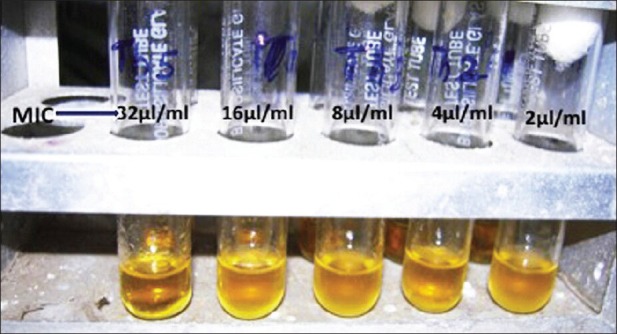
Minimum inhibitory concentration of thyme oil for Staphylococcus aureus
Figure 2.
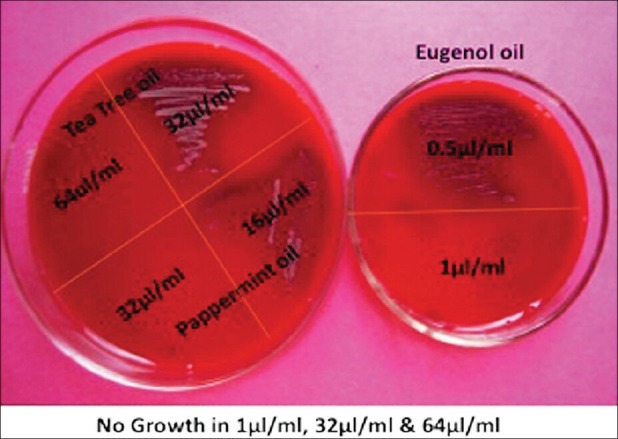
Minimum bactericidal concentration for Enterococcus fecalis
Figure 5.
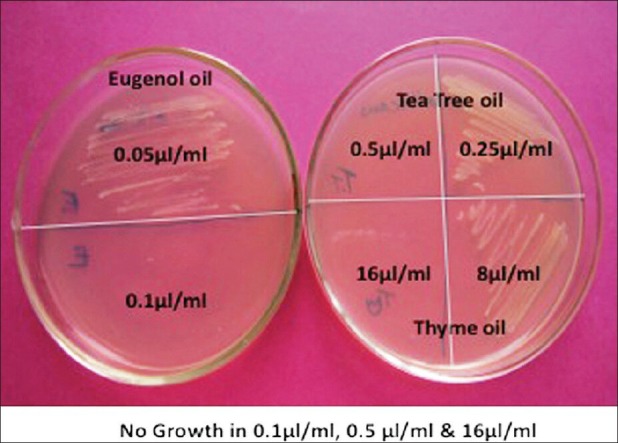
Minimum fungicidal concentration for Candida albicans
Table 1.
Different concentrations of essential oils against common oral pathogens

Figure 3.
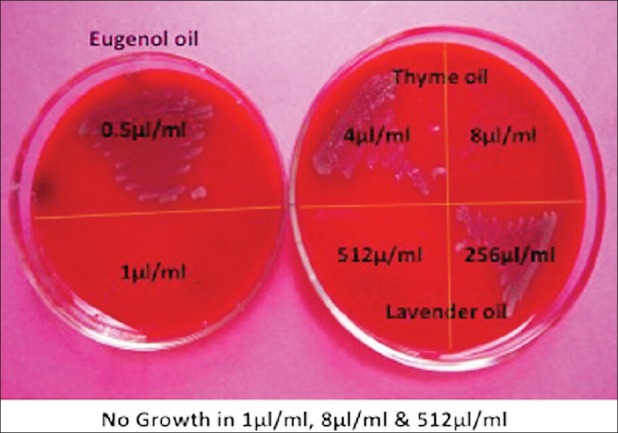
Minimum bactericidal concentration for Escherichia coli
Figure 4.
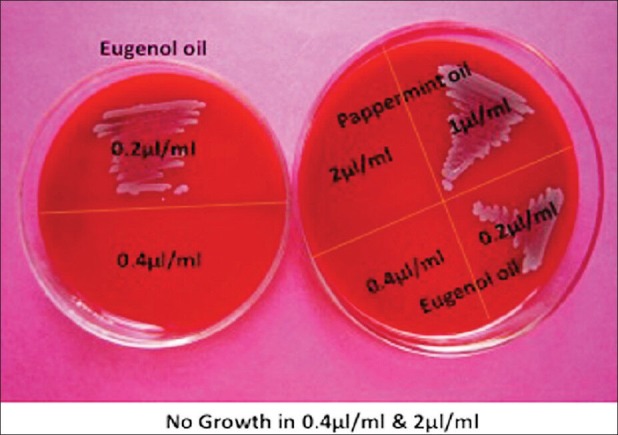
Minimum bactericidal concentration for Stapholococcus aureus
RESULTS
Out of five essential oils, eugenol oil, peppermint oil, tea tree oil exhibited significant inhibitory effect [Table 2] with mean MIC of 0.62 ± 0.45, 9.00 ± 15.34, 17.12 ± 31.25 subsequently. There was no statistical significant difference in five essential oils (F = 1.61, P = 0.221) [Table 3]. Mean MBC/MFC for tea tree oil was 17.12 ± 31.25, for lavender oil 151.00 ± 241.82, for thyme oil 22.00 ± 12.00, for peppermint oil 9.75 ± 14.88 and for eugenol oil 0.62 ± 0.45 (F = 1.30, P = 0.312) [Table 4]. Eugenol showed antimicrobial activity at the lowest concentration compared with all essential oils i.e., for C. albicans: MIC, MFC: 0.1 μl/ml, for S. aureus: MIC, MBC: 0.4 μl/ml, for E. coli and for E. facelis: MIC, MBC: 1 μl/ml respectively [Figures 2–5].
Table 2.
MIC and MBC/MFC of five essential oils (μl/ml)

Table 3.
MIC of five essential oils

Table 4.
MBC/MFC of five essential oils

DISCUSSION
Tea tree oil is the volatile essential oil derived mainly from the Australian native plant, Melaleuca alternifolia. Tea tree oil is composed of terpene hydrocarbons, mainly monoterpenes, sesquiterpenes and their associated alcohols. Terpenes are volatile, aromatic hydrocarbons and may be considered polymers of isoprene, which has the formula C5H8.[9] Antibacterial activity in literature appeared from 1940 to 1980.[10,11,12,13] From the early 1990s onward, many reports describing the antimicrobial activity of tea tree oil appeared in the scientific literature.[9]
Antimicribial activity of tea tree oil is due to terpinen-4-ol, α-terpineol and 1,8-, which cause leakage of 260 nm-light absorbing material and render cells susceptible to sodium chloride.[14] Thus, tea tree oil causes lysis and the loss of membrane integrity and function manifested by the leakage of ions and the inhibition of respiration.[9] Antimicrobial resistant isolates of S. aureus,[15,16] C. albicans,[17] and E. faecium[18,19] have been found to have in vitro susceptibilities to tea tree oil. In this study, antimicrobial effect of tea tree oil for C. albicans (MIC: 0.5 μl/ml, MFC: 0.5 μl/ml) was found at the lowest concentration followed by S. aureus (MIC: 1 μl/ml, MBC: 2 μl/ml) and E. coli (MIC: 2 μl/ml, MBC: 2 μl/ml), lastly E. faecalis (MIC: 64 μl/ml, MBC: 64 μl/ml).
Much of pure lavender oil (Lavandula officianalis L. angustifolia [Miller] or L. vera-Labiatae/Lamiaceae) comes from Balkans. France still produces the finest quality, but production there is tumbled with the advent of the hybrid. Essential oil of lavender is obtained from the flowering tops by steam distillation method. Its principal constituents include monoterpens, Oxides, linalyl and geranyle esters, geraniol, linalool etc., It has variety of properties, which includes that it is anti-depressant, hypotensive, soothing, alleviates stress, anxiety and general debility. It is antiseptic and anti-inflammatory for colds, flu and sinusitis and throat infections. It is balancing, antiseptic, anti-inflammatory and regenerative; soothes acne, eczema, dandruff, hair loss, head lice, diaper/nappy rash, sunburn, insect bites and boils; relieves Athlete's foot and herpes simplex. It has cleansing and calming effect; helps colic, dyspepsia, indigestion, flatulence and gastroenteritis. It is sedative and decongestant; lowers blood pressure reduces palpitations. It has musculo-analgesic and anti-inflammatory effect in neuritis, neuralgia, muscular sprains, cramps, aches and pains. It is also used in inhalations, vaporizers, compresses, bath application or massage.[20] In the study of Zuzarte et al., 2009[21] antifungal activity of lavender oil was found with MIC values of 0.32-0.64 μl/ml. In the study of Zuzarte (2011)[22] candida species, were found to be sensitive to lavender oil with MIC of 0.64 μl/ml. In our study, it was achieved with a higher concentration i.e., 8 μl/ml for C. albicans. S. aureus and E. faecalis were susceptible at the concentration of MIC: 32 μl/ml and MBC: 64 μl/ml respectively. E. coli was least susceptible with MIC: 128 μl/ml and MBC: 512 μl/ml.
The name thyme actually comes from the Greek word “thymos,” meaning small because of the fragrance of the plant. Thyme belongs to over 300 species of hardy, perennial herbaceous plants and shrubs that are native to Europe, particularly around Mediterranian. It is one of the Hippocrates 400 simple remedies. Essential oil of thyme (Thymus Spp, T. citriodorits, T. vulgaris-Labiatae/Lamiaceae) is obtained from the leaves and flowering tops by steam distillation method. Its principal constituents include 20-40% thymol and carvacrol with borneol, cineol, linalool, menthone, B-cymene, pinene and triterpenic acid. Thyme oil is a tonic stimulant and stomachic and digestive relieves gastritis, enterocolitis and mouth thrush. It is useful for respiratory infections, asthma and bronchitis. It is effective for treating swelling provoked by gout or rheumatic problems, for joint pains, backache and sciatica. Thyme oil is also useful for urinary and vaginal infections, endometritis (candida), prostrates and vaginitis.[20] Thyme oil exhibits antibacterial activity and has been useful in dental practice.[23] A component of thyme, known as thymol, appears to inhibit growth of oral pathogens in the mouth and in combination with other essential oils, may reduce dental caries.[24,25] In patients with orthodontic brackets, a dental varnish containing thymol reduced the proportion of Streptococcus mutans in supragingival plaque near the bracket.[26] Thymol is one of the essential oils with antibacterial effects found in Listerine.[27] In the study of Gislene et al., 2000[28] Hili et al.,1997[29] and Nzeako et al., 2006[30] thyme and clove oil possessed antimicrobial activity against S. aureus, E. coli and C. albicans at various concentration of the extracts. In our study, antimicrobial susceptibility in order of sequence for thyme oil was E. coli with MIC: 2 μl/ml, MBC: 8 μl/ml, C. albicans with MIC, MFC: 16 μl/ml, E. faecalis with MIC, MBC: 32 μl/ml and S. aureus with MIC, MBC: 32 μl/ml respectively.
Essential oil of peppermint (Mentha piperita-Lamiaceae/Labiatae) is cultivated on a wide scale in Europe, USA and Japan. It is extensively used in toiletry, food and pharmaceutical industries. A variety of products ranging from toothpastes, mouthwashes and digestive tablets to sweets, ice cream and liquors are flavored with peppermint. Essential oil of peppermint is obtained from the leaves by steam distillation method. Its principal constituents include monoterpinic alcohols mainly menthol (38-48%), ketones mainly menthones (20-30%), some monoterpens and oxides. It is a good antiseptic, antibacterial and antiviral. It has light, clean, refreshing aroma and is a good insect repellant. It has stimulating and strengthening effect; in treatment of shock, helpful for neuralgia and relief of general debility, headaches and migraines. It has antiseptic and anti-spasmodic effect; in reducing mucus and relieving coughs, sinusitis, throat infections, colds, flu, asthma and bronchitis. It is also used in inhalations, baths or applications. It has got cooling and cleansing effect; soothes itchy skin, relieves inflammation. It has soothing and anti-spasmodic effect; relieves acidity, heartburn, diarrhea, indigestion and flatulence, also effective for travel sickness and nausea. It has cooling effect in case of varicose veins and hemorrhoids.[20] Peppermint oil makes the mouth feel fresh and of course, makes the formula taste good. Peppermint oil can also increase salivation, which is useful because dry mouth may result in halitosis.[31] In our study, antimicrobial effect was achieved at the concentration of 0.5 μl/ml for C. albicans and at the concentration of 32 μl/ml for E. coli, S. aureus, E. faecalis (32 μl/ml).
The clove plant grows in warm climates and is cultivated commercially in Tanzania, Sumatra, the Maluku (Molucca) Islands and South America. The tall evergreen plant grows up to 20 m and has leathery leaves. The clove spice is the dried flower bud of Eugenia caryophyllata species. Essential oils are obtained from the buds, stems and leaves by steam distillation. The buds or cloves are strongly aromatic. Clove buds yield approximately 15-20% of a volatile oil that is responsible for the characteristic smell and flavor. The bud also contains a tannin complex, a gum and resin and a number of glucosides of sterols. The principal constituent of distilled clove bud oil (60-90%) is eugenol (4-allyl-2-methoxyphenol). The oil also contains about 10% acetyleugenol and small quantities of gallic acid, sesquiterpenes, furfural and vanillin and methyl-n-amyl ketone. Other constituents include flavonoids, carbohydrates, lipids, oleanolic acid, rhamnetin and vitamins.[32]
Eugenol is widely used and well-known for its medicinal properties. Traditional uses of clove oil include the use in dental care, as an antiseptic and analgesic.[33] It is active against oral bacteria associated with dental caries and periodontal disease[34] and effective against a large number of other bacteria[35,36,37,38] and virus.[39] Previous studies have reported biological activities of eugenol including antifungal,[40,41,42] anti-carcinogenic,[43] anti-allergic,[44,45] anti-mutagenic activity,[46] antioxidant[47] and insecticidal[48] properties. In our study, eugenol oil showed antimicrobial activity at the lowest concentration against all organisms compared with all essential oils such as for C. albicans with MIC, MFC: 0.1 μl/ml, for S. aureus with MIC, MBC: 0.4 μl/ml, for E. coli and for E. facelis with MIC, MBC: 1 μl/ml respectively.
CONCLUSION
Hence, this study concludes that apart from traditional use of eugenol, antibacterial effects of essential oils such as peppermint oil, tea tree oil, thyme oil also can provide an effective intracanal antiseptic solution against oral pathogens.
Footnotes
Source of Support: Nil.
Conflict of Interest: None declared
REFERENCES
- 1.Prabuseenivasan S, Jayakumar M, Ignacimuthu S. In vitro antibacterial activity of some plant essential oils. BMC Complement Altern Med. 2006;6:39. doi: 10.1186/1472-6882-6-39. [DOI] [PMC free article] [PubMed] [Google Scholar]
- 2.Van de Braak SA, Leijten GC. Rotterdam: CBI Centre for the Promotion of Imports from Developing Countries; 1999. Essential Oils and Oleoresins: A Survey in the Netherlands and Other Major Markets in the European Union; p. 116. [Google Scholar]
- 3.Oussalah M, Caillet S, Saucier L, Lacroix M. Antimicrobial effects of selected plant essential oils on the growth of a pseudomonas putida strain isolated from meat. Meat Sci. 2006;73:236–44. doi: 10.1016/j.meatsci.2005.11.019. [DOI] [PubMed] [Google Scholar]
- 4.Sharififar F, Moshafi MH, Mansouri SH, Khodashenas M, Khoshnoodi M. In vitro evaluation of antibacterial and antioxidant activities of the essential oil and methanol extract of endemic Zataria multiflora Boiss. Food Control. 2007;7:800–5. [Google Scholar]
- 5.George S, Kishen A, Song KP. The role of environmental changes on monospecies biofilm formation on root canal wall by Enterococcus faecalis. J Endod. 2005;31:867–72. doi: 10.1097/01.don.0000164855.98346.fc. [DOI] [PubMed] [Google Scholar]
- 6.Noiri Y, Ehara A, Kawahara T, Takemura N, Ebisu S. Participation of bacterial biofilms in refractory and chronic periapical periodontitis. J Endod. 2002;28:679–83. doi: 10.1097/00004770-200210000-00001. [DOI] [PubMed] [Google Scholar]
- 7.Sneddon IB, Glew RC. Contact dermatitis due to propanidid in an anaesthetist. Practitioner. 1973;211:321–3. [PubMed] [Google Scholar]
- 8.Miles RS, Ameys SG. Mackie and Mc Cartney Practical Medical Microbiology. 14th ed. Ch 8 Indian Reprint. Elsevier India Pvt. Ltd: Churchill Livingstone; 2008. Laboratory control of antimicrobial therapy; pp. 151–78. [Google Scholar]
- 9.Carson CF, Hammer KA, Riley TV. Melaleuca alternifolia (Tea Tree) oil: A review of antimicrobial and other medicinal properties. Clin Microbiol Rev. 2006;19:50–62. doi: 10.1128/CMR.19.1.50-62.2006. [DOI] [PMC free article] [PubMed] [Google Scholar]
- 10.Atkinson N, Brice HE. Antibacterial substances produced by flowering plants. II. The antibacterial action of essential oils from some Australian plants. Aust J Exp Biol Med Sci. 1955;33:547–54. doi: 10.1038/icb.1955.56. [DOI] [PubMed] [Google Scholar]
- 11.Beylier MF. Bacteriostatic activity of some Australian essential oils. Perfumer Flavorist. 1979;4:23–5. [Google Scholar]
- 12.Low D, Rawal BD, Griffin WJ. Antibacterial action of the essential oils of some Australian Myrtaceae with special references to the activity of chromatographic fractions of oil of Eucalyptus citriodora. Planta Med. 1974;26:184–5. doi: 10.1055/s-0028-1097987. [DOI] [PubMed] [Google Scholar]
- 13.Walker M. Clinical investigation of Australian Melaleuca alternifolia oil for a variety of common foot problems. Curr Pediatry 1972. 1972:7–15. [Google Scholar]
- 14.Carson CF, Mee BJ, Riley TV. Mechanism of action of Melaleuca alternifolia (tea tree) oil on Staphylococcus aureus determined by time-kill, lysis, leakage, and salt tolerance assays and electron microscopy. Antimicrob Agents Chemother. 2002;46:1914–20. doi: 10.1128/AAC.46.6.1914-1920.2002. [DOI] [PMC free article] [PubMed] [Google Scholar]
- 15.Carson CF, Cookson BD, Farrelly HD, Riley TV. Susceptibility of methicillin-resistant Staphylococcus aureus to the essential oil of Melaleuca alternifolia. J Antimicrob Chemother. 1995;35:421–4. doi: 10.1093/jac/35.3.421. [DOI] [PubMed] [Google Scholar]
- 16.Elsom GK, Hide D. Susceptibility of methicillin-resistant Staphylococcus aureus to tea tree oil and mupirocin. J Antimicrob Chemother. 1999;43:427–8. doi: 10.1093/jac/43.3.427. [DOI] [PubMed] [Google Scholar]
- 17.Vazquez JA, Arganoza MT, Boikov D, Akins RA, Vaishampayan JK. In vitro susceptibilities of Candida and Aspergillus species to Melaleuca alternafolia (tea tree) oil. Rev Iberoam Micol. 2000;17:60–3. [PubMed] [Google Scholar]
- 18.May J, Chan CH, King A, Williams L, French GL. Time-kill studies of tea tree oils on clinical isolates. J Antimicrob Chemother. 2000;45:639–43. doi: 10.1093/jac/45.5.639. [DOI] [PubMed] [Google Scholar]
- 19.Nelson RR. In-vitro activities of five plant essential oils against methicillin-resistant Staphylococcus aureus and vancomycin-resistant Enterococcus faecium. J Antimicrob Chemother. 1997;40:305–6. doi: 10.1093/jac/40.2.305. [DOI] [PubMed] [Google Scholar]
- 20.Ratan R. 2nd ed. Mumbai: Institute of Holistic Health Sciences; 2006. Handbook of Aromatherapy. A Complete Guide to Essential and Carrier Oils, Their Application and Therapeutic Use for Holistic Health and Wellbeing; p. 37. 43, 48. [Google Scholar]
- 21.Zuzarte M, Gonçalves MJ, Cavaleiro C, Dinis AM, Canhoto JM, Salgueiro LR. Chemical composition and antifungal activity of the essential oils of Lavandula pedunculata (Miller) Cav. Chem Biodivers. 2009;6:1283–92. doi: 10.1002/cbdv.200800170. [DOI] [PubMed] [Google Scholar]
- 22.Zuzarte M, Gonc¸alves MJ, Cavaleiro C, Canhoto J, Silva LS, Silva MJ, et al. Chemical composition and antifungal activity of the essential oils of Lavandula viridis L’He×r. J Med Microbiol. 2011;60:612–18. doi: 10.1099/jmm.0.027748-0. [DOI] [PubMed] [Google Scholar]
- 23.Meeker HG, Linke HA. The antibacterial action of eugenol, thyme oil, and related essential oils used in dentistry. (34-5).Compendium. 1988;9:32. 38. [PubMed] [Google Scholar]
- 24.Shapiro S, Guggenheim B. The action of thymol on oral bacteria. Oral Microbiol Immunol. 1995;10:241–6. doi: 10.1111/j.1399-302x.1995.tb00149.x. [DOI] [PubMed] [Google Scholar]
- 25.Yu D, Pearson SK, Bowen WH, Luo D, Kohut BE, Harper DS. Caries inhibition efficacy of an antiplaque/antigingivitis dentifrice. Am J Dent. 2000;13:14C–7. [PubMed] [Google Scholar]
- 26.Sköld-Larsson K, Borgström MK, Twetman S. Effect of an antibacterial varnish on lactic acid production in plaque adjacent to fixed orthodontic appliances. Clin Oral Investig. 2001;5:118–21. doi: 10.1007/s007840100112. [DOI] [PubMed] [Google Scholar]
- 27.Kato T, Iijima H, Ishihara K, Kaneko T, Hirai K, Naito Y, et al. Antibacterial effects of Listerine on oral bacteria. Bull Tokyo Dent Coll. 1990;31:301–7. [PubMed] [Google Scholar]
- 28.Gislene GF, Paulo C, Giuliana L. Antibacterial activity of plant extracts and phytochemicals on antibiotic resistant bacteria. Braz J Microbiol. 2000;31:314–25. [Google Scholar]
- 29.Hili P, Evans CS, Veness RG. Antimicrobial action of essential oils: The effect of dimethylsulphoxide on the activity of cinnamon oil. Lett Appl Microbiol. 1997;24:269–75. doi: 10.1046/j.1472-765x.1997.00073.x. [DOI] [PubMed] [Google Scholar]
- 30.Nzeako BC, Al-Kharousi ZS, Al-Mahrooqui Z. Antimicrobial activities of clove and thyme extracts. Sultan Qaboos Univ Med J. 2006;6:33–9. [PMC free article] [PubMed] [Google Scholar]
- 31.Dawes C, Macpherson LM. Effects of nine different chewing-gums and lozenges on salivary flow rate and pH. Caries Res. 1992;26:176–82. doi: 10.1159/000261439. [DOI] [PubMed] [Google Scholar]
- 32. Available from: http://www.drugs.com . Natural products (Pro) Clove professional information from Drugs.com.
- 33.Oliveira FQ, Gobira B, Guimarães C, Batista J, Barreto M, Souza M. Espécies vegetais indicadas na odontologia. Rev Bras Farm. 2007;17:466–76. [Google Scholar]
- 34.Cai L, Wu CD. Compounds from Syzygium aromaticum possessing growth inhibitory activity against oral pathogens. J Nat Prod. 1996;59:987–90. doi: 10.1021/np960451q. [DOI] [PubMed] [Google Scholar]
- 35.Burt SA, Reinders RD. Antibacterial activity of selected plant essential oils against Escherichia coli O157:H7. Lett Appl Microbiol. 2003;36:162–7. doi: 10.1046/j.1472-765x.2003.01285.x. [DOI] [PubMed] [Google Scholar]
- 36.Larhsini M, Oumoulid L, Lazrek HB, Wataleb S, Bousaid M, Bekkouche K, et al. Antibacterial activity of some Moroccan medicinal plants. Phytother Res. 2001;15:250–2. doi: 10.1002/ptr.815. [DOI] [PubMed] [Google Scholar]
- 37.Cressy HK, Jerrett AR, Osborne CM, Bremer PJ. A novel method for the reduction of numbers of Listeria monocytogenes cells by freezing in combination with an essential oil in bacteriological media. J Food Prot. 2003;66:390–5. doi: 10.4315/0362-028x-66.3.390. [DOI] [PubMed] [Google Scholar]
- 38.Friedman M, Henika PR, Mandrell RE. Bactericidal activities of plant essential oils and some of their isolated constituents against Campylobacter jejuni, Escherichia coli, Listeria monocytogenes, and Salmonella enterica. J Food Prot. 2002;65:1545–60. doi: 10.4315/0362-028x-65.10.1545. [DOI] [PubMed] [Google Scholar]
- 39.Kim HJ, Lee JS, Woo ER, Kim MK, Yang BS, Yu YG, et al. Isolation of virus-cell fusion inhibitory components from Eugenia caryophyllata. Planta Med. 2001;67:277–9. doi: 10.1055/s-2001-11993. [DOI] [PubMed] [Google Scholar]
- 40.Gayoso CW, Lima EO, Oliveira VT, Pereira FO, Souza EL, Lima IO, et al. Sensitivity of fungi isolated from onychomycosis to Eugenia cariophyllata essential oil and eugenol. Fitoterapia. 2005;76:247–9. doi: 10.1016/j.fitote.2004.12.005. [DOI] [PubMed] [Google Scholar]
- 41.Manohar V, Ingram C, Gray J, Talpur NA, Echard BW, Bagchi D, et al. Antifungal activities of origanum oil against Candida albicans. Mol Cell Biochem. 2001;228:111–7. doi: 10.1023/a:1013311632207. [DOI] [PubMed] [Google Scholar]
- 42.Chami F, Chami N, Bennis S, Bouchikhi T, Remmal A. Oregano and clove essential oils induce surface alteration of Saccharomyces cerevisiae. Phytother Res. 2005;19:405–8. doi: 10.1002/ptr.1528. [DOI] [PubMed] [Google Scholar]
- 43.Zheng GQ, Kenney PM, Lam LK. Sesquiterpenes from clove (Eugenia caryophyllata) as potential anticarcinogenic agents. J Nat Prod. 1992;55:999–1003. doi: 10.1021/np50085a029. [DOI] [PubMed] [Google Scholar]
- 44.Kim HM, Lee EH, Hong SH, Song HJ, Shin MK, Kim SH, et al. Effect of Syzygium aromaticum extract on immediate hypersensitivity in rats. J Ethnopharmacol. 1998;60:125–31. doi: 10.1016/s0378-8741(97)00143-8. [DOI] [PubMed] [Google Scholar]
- 45.Corrêa MF, Melo GO, Costa SS. Substâncias de origem vegetal potencialmente úteis na terapia da Asma. Braz J. Pharmacogn. 2008;18(Suppl):785–97. [Google Scholar]
- 46.Miyazawa M, Hisama M. Suppression of chemical mutagen-induced SOS response by alkylphenols from clove (Syzygium aromaticum) in the Salmonella typhimurium TA1535/pSK1002 umu test. J Agric Food Chem. 2001;49:4019–25. doi: 10.1021/jf0103469. [DOI] [PubMed] [Google Scholar]
- 47.Ogata M, Hoshi M, Urano S, Endo T. Antioxidant activity of eugenol and related monomeric and dimeric compounds. Chem Pharm Bull (Tokyo) 2000;48:1467–9. doi: 10.1248/cpb.48.1467. [DOI] [PubMed] [Google Scholar]
- 48.Park IK, Lee HS, Lee SG, Park JD, Ahn YJ. Insecticidal and fumigant activities of Cinnamomum cassia bark-derived materials against Mechoris ursulus (Coleoptera: Attelabidae) J Agric Food Chem. 2000;48:2528–31. doi: 10.1021/jf9904160. [DOI] [PubMed] [Google Scholar]


